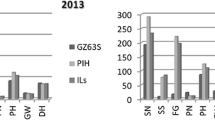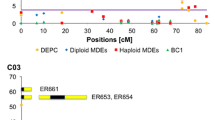Abstract
Introgression libraries can be used to make favorable genetic variation of exotic donor genotypes available in the genetic background of elite breeding material. Our objective was to employ a combination of the Dunnett test and a linear model analysis to identify favorable donor alleles in introgression lines (ILs) that carry long or multiple donor chromosome segments (DCS). We reanalyzed a dataset of two rye introgression libraries that consisted of ILs carrying on average about four donor segments. After identifying ILs that had a significantly better per se or testcross performance than the recipient line with the Dunnett test, the linear model analysis was in most instances able to clearly identify the donor regions that were responsible for the superior performance. The precise localization of the favorable DCS allowed a detailed analysis of pleiotropic effects and the study of the consistency of effects for per se and testcross performance. We conclude that in many cases the linear model analysis allows the assignment of donor effects to individual DCS even for ILs with long or multiple donor segments. This may considerably increase the efficiency of producing sub-ILs, because only such segments need to be isolated that are known to have a significant effect on the phenotype.




Similar content being viewed by others
References
Chetelat RT, Meglic V (2000) Molecular mapping of chromosome segments introgressed from Solanum lycopersicoides into cultivated tomato (Lycopersicon esculentum). Theor Appl Genet 100:232–241
Cochran W, Cox GM (1957) Experimental designs, 2nd edn. Wiley, New York
Coles ND, Zila CT, Holland JB (2011) Allelic effect variation at key photoperiod response quantitative trait loci in maize. Crop Sci 51:1036–1049
Dunnett CW (1955) A multiple comparison procedure for comparing several treatments with a control. J Am Stat Assoc 50:1096–1121
Eduardo I, Arús P, Monforte AJ (2005) Development of a genomic library of near isogenic lines (NILs) in melon (Cucumis melo L.) from the exotic accession PI161375. Theor Appl Genet 112:139–148
Eduardo I, Arús P, Monforte AJ, Obando J, Fernández-Trujillo JP, Martínez JA, Alarcón AL, Álvarez JM, van der Knaap E (2007) Estimating the genetic architecture of fruit quality traits in melon using a genomic library of near isogenic lines. J Am Soc Hortic Sci 132:80–89
Eshed Y, Zamir D (1994) A genomic library of Lycopersicon pennellii in L. esculentum: a tool for fine mapping of genes. Euphytica 79:175–179
Eshed Y, Zamir D (1995) An introgression line population of Lycopersicon pennellii in the cultivated tomato enables the identification and fine mapping of yield-associated QTL. Genetics 141:1147–1162
Eshed Y, Abu-Abied M, Saranga Y, Zamir D (1992) A genome-wide search for wild-species alleles that increase horticultural yield of processing tomatoes. Theor Appl Genet 93:877–886
Falke KC, Frisch M (2011) Power and false positive rate in QTL detection with near-isogenic line libraries. Heredity 106:576–584
Falke KC, Sušić Z, Hackauf B, Korzun V, Schondelmaier J, Wilde P, Wehling P, Wortmann H, Mank R, Rouppe van der Voort J, Maurer HP, Miedaner T, Geiger HH (2008) Establishment of introgression libraries in hybrid rye (Secale cereale L.) from an Iranian primitive accession as a new tool for rye breeding and genomics. Theor Appl Genet 117:641–652
Falke KC, Wilde P, Wortmann H, Geiger HH, Miedaner T (2009a) Identification of genomic regions carrying QTL for agronomic and quality traits in rye (Secale cereale) introgression libraries. Plant Breed 128:615–623
Falke KC, Sušić Z, Wilde P, Wortmann H, Möhring J, Piepho H-P, Geiger HH, Miedaner T (2009b) Testcross performance of rye introgression lines developed by marker-based backcrossing using an Iranian accession as donor. Theor Appl Genet 118:1225–1238
Finkers R, van Heusden AW, Meijer-Dekens F, van Kan JAL, Maris P, Lindhout P (2007) The construction of a Solanum habrochaites LYC4 introgression line population and the identification of QTLs for resistance to Botrytis cinerea. Theor Appl Genet 114:1071–1080
Jeuken MJW, Lindhout P (2004) The development of lettuce backcross inbred lines (BILs) for exploitation of the Lactuca saligna (wild lettuce) germplasm. Theor Appl Genet 109:394–401
Jeuken MJW, Pelgrom K, Stam P, Lindhout P (2008) Efficient QTL detection for nonhost resistance in wild lettuce: backcross inbred lines versus F2 population. Theor Appl Genet 116:845–857
Kearsey MJ (2002) QTL analysis: problems and (possible) solutions. In: Kang MS (ed) Quantitative genetics, genomics and plant breeding. CAB International, New York, pp 45–58
Keurentjes JJB, Bentsink L, Alonso-Blanco C, Hanhart CJ, Vries HBD, Effgen S, Vreugdenhil D, Koornneef M (2007) Development of a near-isogenic line population of Arabidopsis thaliana and comparison of mapping power with a recombinant inbred line population. Genetics 175:891–905
Kosambi DD (1944) The estimation of map distances from recombination values. Ann Eugen 12:172–175
Liu S, Zhou R, Dong Y, Li P, Jia J (2006) Development, utilization of introgression lines using a synthetic wheat as donor. Theor Appl Genet 112:1360–1373
Matus I, Corey A, Filichkin T, Hayes PM, Vales MI, Kling J, Riera-Lizarazu O, Sato K, Powell W, Waugh R (2003) Development and characterization of recombinant chromosome substitution lines (RCSLs) using Hordeum vulgare subsp. spontaneum as a source of donor alleles in a Hordeum vulgare subsp. vulgare background. Genome 46:1010–1023
Patterson HD, Williams ER (1976) A new class of resolvable incomplete block designs. Biometrica 63:83–92
Pestsova EG, Börner A, Röder MS (2006) Development and QTL assessment of Triticum aestivum–Aegilops tauschii introgression lines. Theor Appl Genet 112:634–647
R Development Core Team (2004) R: a language and environment for statistical computing. R Foundation for Statistical Computing, Vienna
Rousseaux MC, Jones CM, Adams D, Chetelat R, Bennett A, Powell A (2005) QTL analysis of fruit antioxidants in tomato using Lycopersicon pennellii introgression lines. Theor Appl Genet 111:1396–1408
SAS Institute (2004) Version 8.2. SAS Inst., Cary, NC
Schmalenbach I, Pillen K (2009) Detection and verification of malting quality QTLs using wild barley introgression lines. Theor Appl Genet 118:1411–1427
Schmalenbach I, Körber N, Pillen K (2008) Selecting a set of wild barley introgression lines and verification of QTL effects for resistance to powdery mildew and leaf rust. Theor Appl Genet 117:1093–1106
Schmalenbach I, Léon J, Pillen K (2009) Identification and verification of QTLs for agronomic traits using wild barley introgression lines. Theor Appl Genet 118:483–497
Schmalenbach I, March TJ, Bringezu T, Waugh R, Pillen K (2011) High-resolution genotyping of wild barley introgression lines and fine-mapping of the threshability locus thresh-1 using the Illumina GoldenGate assay. G3: Genes. Genomes Genetics 1:187–196
Szalma SJ, Hostert BM, LeDeaux JR, Stuber CW, Holland JB (2007) QTL mapping with near-isogenic lines in maize. Theor Appl Genet 114:1211–1228
Tanksley SD, Nelson JC (1996) Advanced backcross QTL analysis: a method for the simultaneous discovery and transfer of valuable QTL from unadapted germplasm into elite breeding lines. Theor Appl Genet 92:191–203
Utz HF (2001) PLABSTAT: a computer program for the statistical analysis of plant breeding experiments. Institute for Plant Breeding, Seed Science and Population Genetics, University of Hohenheim, Stuttgart
Van Ooijen JW, Voorrips RE (2001) JoinMap version 3.0: software for the calculation of genetic linkage maps. Plant Research International, Wageningen
Wang J, Wan X, Li H, Pfeiffer WH, Crouch J, Wan J (2007) Application of identified QTL-marker associtions in rice quality improvement through a design-breeding approach. Theor Appl Genet 115:87–100
Wang J, Wan X, Crossa J, Crouch J, Weng J, Zhai H, Wan J (2006) QTL mapping of grain length in rice (Oryza sativa L.) using chromosome segment substitution lines. Genet Res Camb 88:93–104
Zamir D (2001) Improving plant breeding with exotic genetic libraries. Nat Rev Genet 2:983–989
Acknowledgments
This article is dedicated to Professor Dr. Dr. h.c. Wolfgang Friedt on the occasion of his 65th birthday. Funding from the German Federal Ministry of Education and Research (BMBF Grants #0312289B and 315951C), the German Federal Ministry of Economics (Aif Grant #KF0141101MD5), the German Federal Minsitry of Food, Agriculture, and Consumer’s Protection (BMELV) via the Federal Agency for Agriculture and Food (BLE) and the “Gemeinschaft zur Förderung der privaten deutschen Pflanzenzüchtung” (GFP), Grant no. PGI-06.01-28-1-43.017-07, and the breeding companies Hybro GmbH & Co. KG, Schenkendorf, and KWS LOCHOW GmbH, Bergen are gratefully acknowledged. We thank M. Raith (University of Hohenheim), J.-C. Gudehus (KWS LOCHOW GmbH, Bergen), Dr. F.J. Fromme (Hybro GmbH & Co KG, Schenkenberg) for conducting the field trials and Dr. V. Korzun (KWS LOCHOW GmbH), Dr. B. Hackauf (JKI, Gross Lüsewitz), and Dr. J. Schondelmaier (SAATEN-UNION Resistenzlabor, Leopoldshöhe) for their support with the marker analyses.
Author information
Authors and Affiliations
Corresponding author
Additional information
Communicated by X. Xia.
Electronic supplementary material
Below is the link to the electronic supplementary material.
Rights and permissions
About this article
Cite this article
Mahone, G.S., Frisch, M., Miedaner, T. et al. Identification of quantitative trait loci in rye introgression lines carrying multiple donor chromosome segments. Theor Appl Genet 126, 49–58 (2013). https://doi.org/10.1007/s00122-012-1958-8
Received:
Accepted:
Published:
Issue Date:
DOI: https://doi.org/10.1007/s00122-012-1958-8




